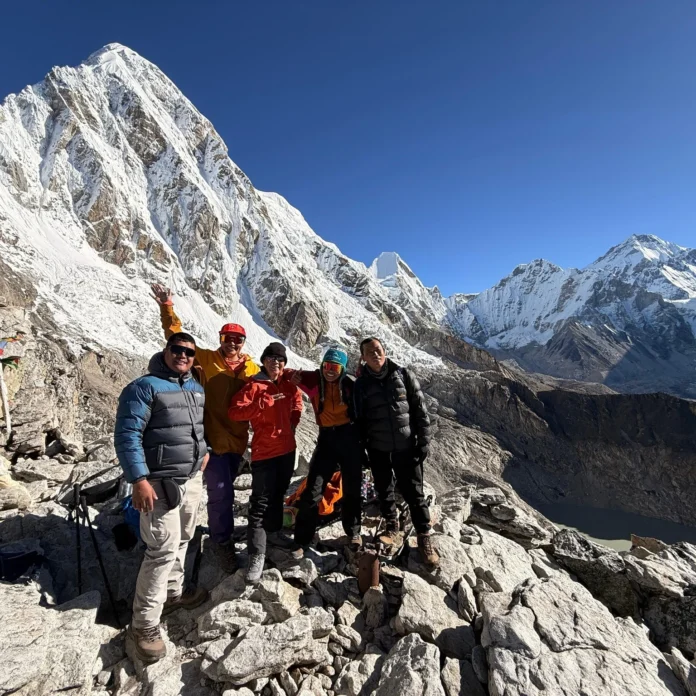You’ve just booked your trek to Everest Base Camp, and the excitement is real—until it hits you: you’re not in shape. Maybe your idea of a hike is walking the dog around the block, or your gym membership has been collecting dust. With only three months to go, the challenge ahead feels massive, but don’t worry—you’re not alone, and it’s absolutely doable.
Reaching Everest Base Camp isn’t just about altitude; it’s about endurance, mental grit, and preparation. The trail stretches over 80 miles round-trip, with steep climbs, rocky terrain, and thin air testing every step. Without the right training, even the most enthusiastic adventurer can struggle. That’s where the right plan makes all the difference.
This guide offers the best training plan for Everest Base Camp, designed specifically for beginners starting from the couch. Whether you’re short on time, unsure where to start, or overwhelmed by conflicting advice, this plan breaks it down into manageable, weekly goals. You’ll build strength, stamina, and confidence—so when you finally step onto the trail, you’ll be ready to enjoy every breathtaking moment.
If you’re short on time, consider combining the Everest Base Camp Trek with Helicopter Return. It reduces the physical toll of the return journey while still letting you experience the magic of reaching Base Camp.
No fancy gear or prior experience required—just commitment and a clear path forward. Let’s turn that dream into a reality, one step at a time.
Why You Need a Training Plan for Everest Base Camp
Is Everest Base Camp Trek Physically Demanding?
Absolutely. The Everest Base Camp (EBC) trek is not a technical climb, but it’s physically and mentally demanding. You’ll be hiking for 12–14 days, covering 5–10 miles daily with significant elevation gain. The trail reaches a maximum altitude of 5,364 meters (17,598 feet), where oxygen levels drop to about 50% of sea level.
You’ll be walking on rocky, uneven terrain, often uphill for hours at a time. Weather conditions can vary wildly, from sunny mornings to snowstorms in the afternoon. Add to that the effects of high altitude—fatigue, headaches, and shortness of breath—and it becomes clear: this trek is no walk in the park.
Even if you’re moderately fit, the combination of altitude and sustained effort can wear you down. That’s why targeted physical preparation is key to success.
What Happens If You Don’t Train?
Skipping training is a gamble. Without proper preparation, you’re more prone to injuries like knee strain, blisters, or back pain from carrying a loaded pack. More importantly, poor fitness can increase your risk of altitude sickness, especially if your body struggles to acclimatize.
Untrained trekkers often experience:
- Early fatigue, limiting how far they can go each day.
- Slower recovery times between trekking days.
- Mental burnout from physical discomfort.
- Higher chance of needing evacuation due to exhaustion or illness.
Worst-case scenario? You may not reach Base Camp at all. Many trekkers have to turn back due to preventable physical limitations. A structured training plan dramatically improves your chances of completing the trek safely and enjoying the journey.
How Fit Do You Need to Be for Everest Base Camp?
Fitness Level Required for EBC Trek
To successfully complete the Everest Base Camp trek, you don’t need to be an elite athlete—but you do need solid cardiovascular endurance, leg strength, and stamina. Ideally, you should be able to hike for 5–6 hours a day, multiple days in a row, with a 6–8 kg (13–18 lb) backpack.
Your resting heart rate and recovery time after exertion are good indicators of fitness. If you can climb 10–15 flights of stairs without gasping, or complete a 3-hour hike with moderate elevation gain and feel good afterward, you’re on the right track.
You should also be comfortable walking on uneven terrain, navigating rocky paths, and handling changes in weather. Strength in your core and legs will help prevent injuries, especially in your knees and lower back.
Can Beginners or Couch Potatoes Do It?
Yes—if you commit to a structured training plan. Many first-time trekkers, including those with sedentary lifestyles, have successfully reached Everest Base Camp. What matters most is consistency and progression.
The key is starting early. With 12 weeks of focused training, even beginners can build the endurance and strength needed. The first month lays the foundation, while months two and three simulate actual trekking conditions.
Be realistic about your starting point. If you haven’t exercised in a while, begin with walking and gentle strength exercises. Gradually increase intensity and duration. Listen to your body, and don’t skip recovery days.
Remember, EBC is a trek, not a race. Mental resilience, determination, and preparation often matter more than raw athleticism.
3-Month Everest Base Camp Training Plan Overview
What’s the Goal of This Training Plan?
This 3-month Everest Base Camp training plan is designed to transform you from sedentary to trail-ready. The primary goals are:
- Build cardiovascular endurance for long hiking days.
- Strengthen muscles used in trekking—especially legs, core, and shoulders.
- Prepare your body for carrying a backpack on uneven terrain.
- Improve recovery and injury prevention.
- Mentally condition yourself for physical discomfort and altitude stress.
By the end of the plan, you should be able to complete back-to-back hikes of 5–7 hours while carrying your gear, recover overnight, and feel confident in your physical and mental readiness.
Weekly Time Commitment
Training doesn’t have to take over your life. On average, plan to commit:
- Month 1: 4–5 hours per week.
- Month 2: 6–7 hours per week.
- Month 3: 7–9 hours per week.
Each week includes:
- 3–4 cardio sessions (walking, hiking, jogging, or stair climbing).
- 2 strength training sessions.
- 1–2 rest or recovery days.
Weekend hikes become progressively longer. You’ll simulate trail conditions by wearing your pack and hiking on hilly or uneven terrain.
Consistency is more important than intensity. Stick to the plan, and you’ll build the stamina needed to thrive on the trail.
Month 1 – Building a Fitness Foundation
Focus Areas: Cardio & Core Strength
The first month is all about easing your body into a regular fitness routine. Your primary focus areas are:
- Cardiovascular endurance: Start with brisk walking or light jogging.
- Core strength: Engage your abs, lower back, and hips to support posture and balance.
- Flexibility: Stretch regularly to prevent injury and improve mobility.
Aim for low-impact activities like:
- 30–45 minutes of walking or light jogging, 3–4 times per week.
- 2 strength sessions focusing on bodyweight exercises (planks, squats, lunges, push-ups).
- Daily stretching or yoga for 10–15 minutes.
Don’t forget recovery. Rest days are crucial to allow your muscles to adapt and grow stronger.
Sample Weekly Training Schedule (Month 1)
- Monday: 30-minute brisk walk + core workout
- Tuesday: Rest or light stretching
- Wednesday: 45-minute walk or light jog + lower body strength training
- Thursday: Rest
- Friday: 30-minute walk + core workout
- Saturday: 1–2 hour hike or long walk
- Sunday: Rest or yoga
Tips for Staying Motivated in the First Month
- Set mini-goals, like completing a 5K walk or mastering a 1-minute plank.
- Track your workouts in a journal or app.
- Join a local hiking group or online community for support.
- Celebrate small wins—consistency is a victory in itself.
Month 2 – Increasing Endurance and Elevation
Focus Areas: Long Hikes & Hill Training
Now it’s time to increase your stamina and simulate the mountain environment. Focus on:
- Long hikes: Aim for 2–4 hour hikes on weekends.
- Hill training: Use stairs, inclines, or a treadmill set to 10–15% grade.
- Weighted pack training: Start carrying a 5–7 kg backpack to build shoulder and back strength.
Continue core and leg strength workouts, and add dynamic movements like step-ups and stair lunges. These mimic the trail’s uneven surfaces.
Sample Weekly Training Schedule (Month 2)
- Monday: 45-minute incline walk or stair climb
- Tuesday: Core + leg strength workout
- Wednesday: 60-minute walk with light pack
- Thursday: Rest or yoga
- Friday: 45-minute hill intervals + core
- Saturday: 3–4 hour hike with weighted pack
- Sunday: 1–2 hour recovery walk or rest
How to Simulate Altitude at Home
While you can’t replicate altitude exactly, you can prepare your body by:
- Training with a weighted backpack to mimic physical exertion at altitude.
- Using an altitude training mask (optional) to restrict airflow and build respiratory strength.
- Practicing breath control during cardio to improve oxygen efficiency.
- Sleeping in a hypoxic tent (for advanced users under medical guidance).
Always consult a physician before using altitude-related gear like hypoxic tents or masks.
Month 3 – Trek-Specific Conditioning
Focus Areas: Back-to-Back Hikes & Strength Training
This is your peak training month. You’ll now focus on:
- Back-to-back hikes: Mimic trekking days by hiking Saturday and Sunday.
- Strength training: Increase intensity with resistance bands or weights.
- Trail simulation: Train on rocky, uneven paths with full gear.
Continue cardio during the week to maintain endurance. Prioritize recovery tools like foam rolling and stretching.
Sample Weekly Training Schedule (Month 3)
- Monday: Rest or yoga
- Tuesday: 60-minute incline treadmill + core workout
- Wednesday: Lower body strength + 30-minute walk
- Thursday: Rest or light stretching
- Friday: 45-minute stair intervals + pack carry
- Saturday: 5–6 hour hike with full gear
- Sunday: 3–4 hour hike (easier trail)
Final Gear Check and Mental Prep
Use this month to test:
- Trekking boots and socks—no new gear on the trail!
- Backpack fit and comfort
- Layering system for cold and warm weather
Start visualizing the trek. Read blogs, watch videos, and mentally prepare for long days, basic amenities, and altitude effects. Confidence is as important as conditioning.
What to Eat While Training for Everest Base Camp
Nutrition Tips for Trek Training
Fueling your body properly boosts performance and recovery. Focus on:
- Complex carbs: Brown rice, oats, sweet potatoes for sustained energy.
- Lean protein: Chicken, tofu, legumes to support muscle repair.
- Healthy fats: Avocados, nuts, olive oil for long-lasting fuel.
- Pre-workout snacks: Banana with peanut butter or a granola bar.
- Post-workout recovery: Protein shake or a balanced meal within 30 minutes.
Avoid processed foods and sugary snacks. Instead, eat whole, nutrient-dense meals to support your training.
Hydration and Altitude Acclimatization
Dehydration worsens altitude sickness. Build hydration habits now:
- Drink at least 2.5–3 liters of water daily.
- Add electrolytes during long hikes or hot days.
- Limit caffeine and alcohol, both of which dehydrate.
During the trek, aim for 4–5 liters per day. Proper hydration improves circulation, reduces fatigue, and helps your body acclimatize.
Altitude sickness can affect anyone, regardless of fitness. Consult your doctor about medications like acetazolamide (Diamox) and follow a gradual ascent profile.
Common Training Mistakes to Avoid
Overtraining and Injury Risks
More isn’t always better. Signs of overtraining include:
- Persistent fatigue
- Trouble sleeping
- Decreased performance
- Mood swings or irritability
To avoid injury:
- Warm up before every session.
- Stretch after workouts.
- Cross-train to avoid repetitive strain.
Listen to your body. If pain persists, rest and consult a professional.
Ignoring Altitude Preparation
Many trekkers focus only on cardio. But altitude requires more:
- Strength to carry your pack and maintain posture.
- Mental toughness to push through discomfort.
- Acclimatization strategies like slow ascent and hydration.
Don’t assume fitness alone will protect you from altitude sickness. Respect the mountain.
Final Checklist: Are You Ready for Everest Base Camp?
Physical Readiness Signs
You’re ready if you can:
- Hike 6 hours with a 7–10 kg pack and recover by the next day.
- Complete back-to-back hikes without injury.
- Maintain steady breathing during stair climbs or hill walks.
You should also be comfortable in your gear—boots, backpack, and layers. No surprises on the trail.
Mental and Logistical Readiness
Mental toughness matters. Ask yourself:
- Can I push through fatigue?
- Am I okay with basic toilets and simple meals?
- Do I feel excited, not just nervous?
Logistically, ensure:
- Flights, permits, and insurance are booked.
- You’ve packed according to an EBC gear checklist.
- Vaccinations and medications are sorted
Conclusion: Start Your Everest Base Camp Journey Today
With just three months to prepare, the right training plan can take you from the couch to Everest Base Camp confidently. The key takeaways? Build endurance gradually, strengthen your legs and core, and practice hiking with a loaded backpack. Don’t forget altitude acclimatization strategies and rest—both are essential for success.
Consistency is more important than perfection. Even on tough days, showing up matters. Trust the process, listen to your body, and adjust when needed. You’re training not just your muscles, but your mindset.
Now’s the time to commit. Lace up your boots, print your training calendar, and take that first step. Everest Base Camp isn’t just a destination—it’s a journey you’re ready to begin. Let’s hit the trail!












